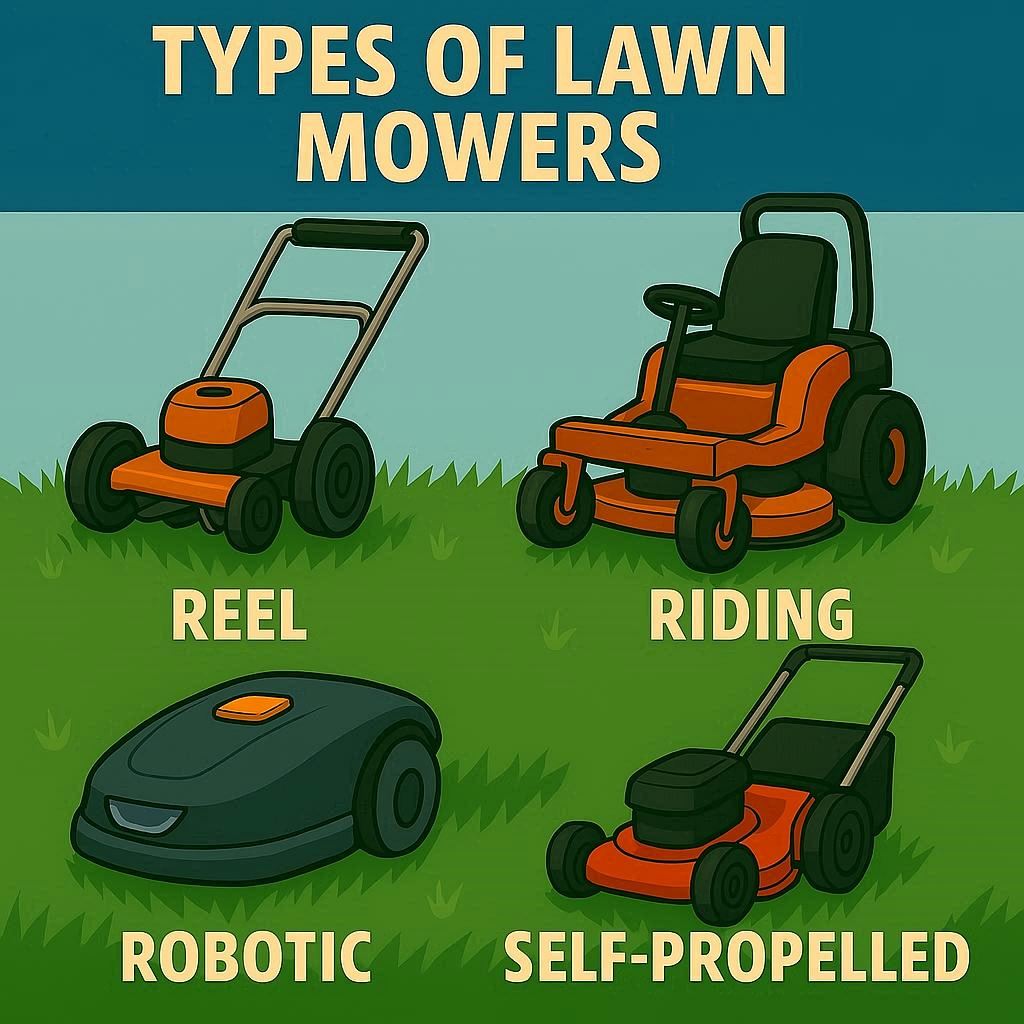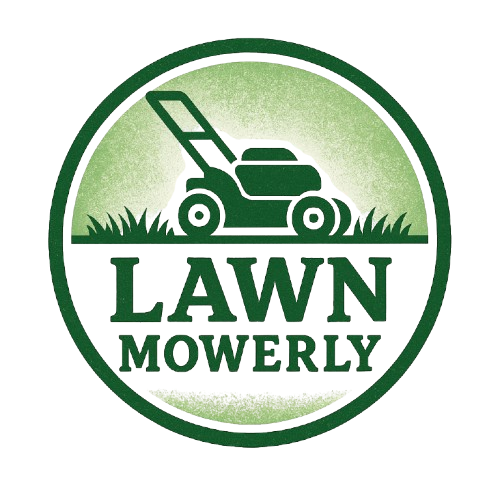
Maintaining a lush, well-manicured lawn requires the right type of lawn mower. Over the years, numerous designs have emerged to suit different lawn sizes, terrains, and user preferences. From traditional push mowers to robotic AI-powered models, each type comes with its own features, advantages, and limitations. This guide explores 15+ types of lawn mowers, with examples, pros, and cons to help you make an informed decision.
1. Push Reel Lawn Mower
The push reel mower is the traditional, manual mower powered entirely by human effort. It uses a set of rotating blades that spin as the user pushes the mower, creating a scissor-like cut. These mowers are ideal for small, flat lawns and are eco-friendly since they produce no emissions or noise.
Examples: Fiskars StaySharp, Scotts Classic 20-Inch Reel Mower
Pros:
- Environmentally friendly, no fuel or electricity required
- Quiet operation
- Low maintenance
Cons:
- Physically demanding, especially for large lawns
- Limited cutting width and height adjustment
- Not suitable for tall or thick grass
Best For: Small, well-kept lawns where quiet, eco-friendly operation is valued.
2. Electric Corded Lawn Mower
Electric corded mowers use electricity supplied via a power cord. They are lightweight and ideal for small to medium-sized lawns. They offer a clean and quiet operation without the need for gas or oil.
Examples: Greenworks 20-Inch Electric Mower, Sun Joe MJ401E
Pros:
- Low noise
- Lightweight and easy to maneuver
- No gas or oil required
Cons:
- Limited by cord length
- Risk of accidentally cutting the cord
- Not suitable for very large lawns
Best For: Small urban lawns with easy access to electrical outlets.
3. Battery-Powered (Cordless) Lawn Mower
Battery-powered or cordless electric mowers use rechargeable lithium-ion batteries. They offer the freedom of movement without a cord and are quieter and eco-friendlier than gas mowers.
Examples: EGO Power+ LM2142SP, Greenworks 40V 21-Inch
Pros:
- Cord-free operation
- Quiet and eco-friendly
- Easy to start with a push-button
Cons:
- Limited battery life for large lawns
- Higher initial cost
- Batteries require replacement over time
Best For: Medium-sized lawns where mobility and eco-friendliness are priorities.
4. Gas-Powered Lawn Mower
Gas mowers are among the most powerful types and are commonly used for large lawns. They can handle tall, thick grass and uneven terrain more effectively than electric or manual mowers.
Examples: Honda HRX217VKA, Toro Recycler 20332
Pros:
- Powerful, ideal for thick or tall grass
- Suitable for large lawns
- Self-propel options available
Cons:
- Noisy and produces emissions
- Requires regular maintenance (oil, spark plug, air filter)
- Heavier than electric models
Best For: Large lawns and areas where electric power is impractical.
5. Self-Propelled Lawn Mower
Self-propelled mowers have a drive system that moves the mower forward, reducing the effort required to push it. They can be gas or electric powered.
Examples: Toro 60V MAX, Honda HRJ216
Pros:
- Less physical effort, ideal for hilly lawns
- Consistent speed for even cutting
- Can handle larger areas efficiently
Cons:
- More expensive than push mowers
- Requires more maintenance for the drive system
- Heavier and bulkier
Best For: Medium to large lawns, especially on inclines or uneven terrain.
6. Hover Lawn Mower
Hover mowers float above the grass using an air cushion, making them easy to maneuver in tight spaces or on slopes. They are typically electric and lightweight.
Examples: Flymo EasiGlide 330VX, Sun Joe MJ401E
Pros:
- Easy to handle, especially on slopes
- Lightweight and compact
- Great for intricate lawn shapes
Cons:
- Not ideal for tall or thick grass
- Short battery life for cordless models
- Less durable than traditional mowers
Best For: Small lawns with slopes or awkward shapes.
7. Robotic Lawn Mower
Robotic mowers are autonomous, AI-driven machines that cut grass automatically. They use sensors and boundary wires or GPS to navigate.
Examples: Husqvarna Automower, Worx Landroid
Pros:
- Fully autonomous, saves time and effort
- Eco-friendly and quiet
- Ideal for consistent lawn maintenance
Cons:
- Expensive initial investment
- Limited cutting capacity for very large lawns
- Requires setup and occasional maintenance
Best For: Busy homeowners with medium to large lawns seeking convenience.
8. Zero-Turn Riding Lawn Mower
Zero-turn mowers are ride-on mowers with a zero-turn radius, making them highly maneuverable. They are ideal for large lawns with obstacles.
Examples: Husqvarna Z254F, John Deere Z345R
Pros:
- Fast and efficient for large areas
- Excellent maneuverability around obstacles
- Reduces mowing time significantly
Cons:
- Expensive
- Requires storage space
- Learning curve for operation
Best For: Large residential or commercial lawns with complex layouts.
9. Stand-On Lawn Mower
Stand-on mowers are ride-on mowers designed for operators to stand while mowing. They offer excellent visibility and maneuverability.
Examples: Scag V-Ride, Exmark Vantage S-Series
Pros:
- Fast and highly maneuverable
- Compact for tight spaces
- Comfortable for extended use
Cons:
- Expensive
- Not ideal for very small lawns
- Limited storage convenience
Best For: Commercial lawns and landscaping businesses.
10. Mulching Lawn Mower
Mulching mowers finely chop grass and redistribute it back onto the lawn as natural fertilizer. They can be push, electric, or self-propelled.
Examples: Toro Recycler, Husqvarna 121C
Pros:
- Eco-friendly, reduces yard waste
- Promotes healthier lawns
- Reduces need for bagging
Cons:
- Can clog if grass is too wet
- Less suitable for very high or thick grass
- May require more frequent mowing
Best For: Homeowners who want nutrient-rich grass clippings and minimal waste.
11. Rear-Engine Riding Lawn Mower
Rear-engine mowers have engines positioned at the back, making them compact and suitable for smaller lawns.
Examples: Cub Cadet RZT-S 42, Troy-Bilt Pony
Pros:
- Compact and easy to store
- Maneuverable for small yards
- Less expensive than zero-turn mowers
Cons:
- Slower than zero-turn mowers
- Not suitable for very large lawns
- Smaller cutting width
Best For: Medium-sized residential lawns needing a ride-on option.
12. Front-Engine Riding Lawn Mower
Front-engine mowers are larger than rear-engine models and are suitable for medium to large lawns. They provide better traction on uneven terrain.
Examples: John Deere X350, Husqvarna YTH18542
Pros:
- Powerful and durable
- Suitable for medium to large lawns
- Can attach garden tools and trailers
Cons:
- Expensive
- Requires storage space
- Larger footprint than rear-engine models
Best For: Medium to large residential properties requiring efficiency and durability.
13. Lawn Tractor
Lawn tractors are heavy-duty, ride-on mowers with the ability to tow attachments like carts, spreaders, and snow plows.
Examples: John Deere X300, Cub Cadet XT1 LT50
Pros:
- Versatile for multiple yard tasks
- Can handle very large lawns
- Comfortable for extended use
Cons:
- Very expensive
- Requires storage space
- Less maneuverable than zero-turn mowers
Best For: Large properties and multi-purpose yard maintenance.
14. Battery-Powered Robotic Mower
These are fully autonomous, battery-powered robotic mowers that combine cordless convenience with AI navigation.
Examples: Worx Landroid L, Ambrogio L60
Pros:
- Saves time and effort
- Eco-friendly and quiet
- Maintains consistent lawn height
Cons:
- High initial cost
- Requires setup and maintenance
- Limited battery runtime for very large lawns
Best For: Tech-savvy homeowners with medium lawns who want automated care.
15. Commercial or Professional Mower
Designed for landscapers and professionals, these mowers are high-performance, heavy-duty machines. They can be ride-on, zero-turn, or walk-behind.
Examples: Toro GrandStand, Exmark Lazer Z
Pros:
- Extremely durable
- Can handle large areas efficiently
- Powerful engines for all conditions
Cons:
- Very expensive
- Requires training to operate safely
- Large storage footprint
Best For: Landscaping companies or large estate maintenance.
16. Hover Electric Mower (Special Mention)
Hover mowers are lightweight electric mowers that float on a cushion of air. They are great for uneven or sloped lawns.
Examples: Flymo Turbo 400, Bosch Rotak 32
Pros:
- Easy to maneuver
- Lightweight and compact
- Suitable for slopes and small lawns
Cons:
- Not for thick or tall grass
- Short battery life for cordless models
- Less durable than traditional mowers
Best For: Small, sloped, or irregular lawns requiring easy handling.
Comparison Table for Types of Lawn Mowers
| Type | Power Source | Ideal Lawn Size | Key Feature | Pros | Cons |
|---|---|---|---|---|---|
| Push Reel | Manual | Small | Scissor-like cut | Eco-friendly, quiet, low maintenance | Physically demanding, not for tall grass |
| Electric Corded | Electricity | Small-Medium | Continuous power | Quiet, lightweight, low maintenance | Limited by cord, not for large lawns |
| Battery-Powered (Cordless) | Lithium-ion battery | Small-Medium | Cordless convenience | Quiet, eco-friendly, portable | Limited battery life, expensive |
| Gas-Powered | Gasoline | Medium-Large | Powerful engine | Handles tall/thick grass, self-propel option | Noisy, emissions, maintenance-heavy |
| Self-Propelled | Gas/Electric | Medium-Large | Mover drives itself | Less effort, efficient on inclines | Expensive, heavier |
| Hover Mower | Electric | Small | Floats on air cushion | Lightweight, easy on slopes | Not for tall grass, less durable |
| Robotic Mower | Battery/AI | Small-Medium | Autonomous mowing | Fully automated, quiet | Expensive, setup required |
| Zero-Turn Riding | Gas/Electric | Large | Zero-turn radius | Fast, maneuverable | Expensive, storage-heavy |
| Stand-On Mower | Gas | Large | Operator stands | Compact, maneuverable | Expensive, not for small lawns |
| Mulching Mower | Gas/Electric | Small-Medium | Mulches grass into lawn | Eco-friendly, nutrient-rich | May clog, frequent mowing needed |
| Rear-Engine Riding | Gas | Medium | Engine at rear | Compact, easy to maneuver | Slower, smaller cutting width |
| Front-Engine Riding | Gas | Medium-Large | Engine at front | Powerful, durable | Expensive, larger footprint |
| Lawn Tractor | Gas | Large | Tow attachments | Versatile, comfortable | Very expensive, storage-heavy |
| Commercial/Professional | Gas/Electric | Large | Heavy-duty use | Durable, efficient | Expensive, requires skill |
FAQs: Lawn Mowers
Q1: What type of mower is best for a small yard?
A1: Push reel mowers, electric corded, or battery-powered mowers are ideal for small yards because they are lightweight, quiet, and easy to maneuver.
Q2: Which mower is best for large lawns?
A2: Gas-powered self-propelled, zero-turn, or lawn tractors are suitable for large lawns due to their power, efficiency, and speed.
Q3: Are robotic mowers worth the investment?
A3: Yes, if you want automated mowing with minimal effort. They are quiet, eco-friendly, and ideal for medium-sized lawns but are expensive and require setup.
Q4: What’s the difference between self-propelled and push mowers?
A4: Self-propelled mowers have a drive system that moves the mower forward, reducing user effort, whereas push mowers require manual pushing.
Q5: Can electric mowers handle thick or tall grass?
A5: Electric mowers are suitable for regularly maintained lawns. Very tall or dense grass is better managed with gas-powered mowers.
Q6: How often should I maintain my mower?
A6: Clean after every use, sharpen blades regularly, check belts and cables, and perform engine maintenance for gas mowers at least once per season.
Q7: What mower is best for hilly terrain?
A7: Self-propelled mowers, hover mowers, or zero-turn mowers with traction are ideal for slopes, as they reduce effort and improve control.
Q8: Are mulching mowers better than bagging mowers?
A8: Mulching mowers recycle grass into the lawn as fertilizer, which is eco-friendly. Bagging mowers collect grass clippings, reducing risk of uneven distribution but requiring disposal.
Conclusion
Choosing the right lawn mower depends on your lawn size, terrain, budget, and maintenance preferences. For small lawns, push reel or electric mowers are ideal.
References

I’m David man behind Lawn Mowerly; I’ve been dealing with lawnmowers and Tractors with my father since I was a kid. I know every make and model and what each one is capable of and love helping people find the perfect equipment for their needs.
